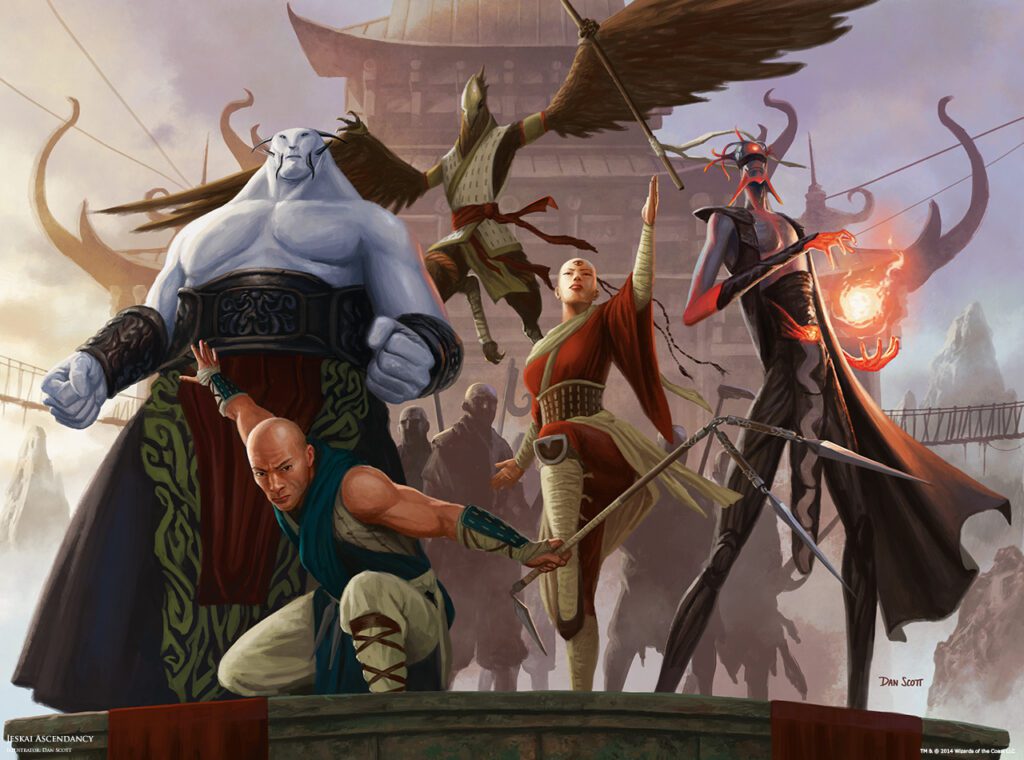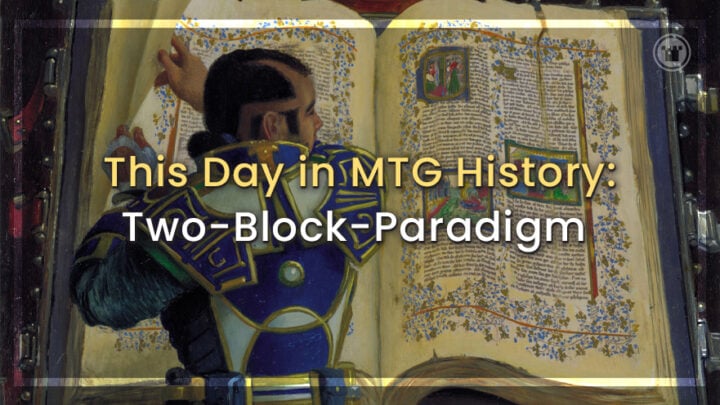Welcome back to another edition of “This Day in Magic History.” Today, we’re going to go back to 2014 and the announcement of the Two-Block Paradigm in MTG. This moment changed the way Magic sets were released, and we’re still feeling the ramifications of it today. This also seems like a particularly good time to discuss the ways that sets dropped, historically, since Wizards of the Coast revealed their schedule for 2022-2023 last week.
Before the Two-Block Paradigm
Before we dive into what changed in 2014, let’s briefly discuss the history of Magic: the Gathering blocks and release schedules. Before the “Two-Block Paradigm” began, there had been two major stages in the way Wizards of the Coast released sets.
Stage 1 (1993-1996): Sets were released and designed individually, without any sort of continuity between sets. Ice Age and Alliances were an exception to this, as they both had the same setting. However, Homelands was released between them, and wasn’t connected to the other two sets at all. Retroactively, the three sets together came to be known as “Ice Age Block,” but it was kind of a stretch to include all three sets. It was such a disappointing set and Block that Wizards of the Coast retconned it 10 years later with the release of Coldsnap, which replaced Homelands as the third set in Ice Age Block.

Stage 2 (1996-2015) Starting with Mirage Block and ending with Khans of Tarkir Block, the Magic year consisted of three consecutive sets that were connected both mechanically and story-wise. This was called a “block.” The first set was large, while the other two sets were smaller. This was the “One Block Paradigm.” In other words, one block came out every year, as well as one Core Set.
That brings us to the event that occurred exactly eight years ago: The announcement of the Two-Block Paradigm on Aug. 25, 2014.
Rise (and fall) of the Two-Block Paradigm
The “One-Block Paradigm” had existed for quite some time by 2014, but Wizards of the Coast decided to change things up that year. As the name suggests, each year would now have two blocks. The blocks would consist of one big set and one small set, and core sets were discontinued entirely. Standard rotation would also now occur following each Block, theoretically making for a more dynamic format.
However, this new release schedule had some problems. Core Sets had long served an important role, because they could be made up of cards from a variety of settings, including lots of reprints that might be good for a particular format. Meanwhile, blocks really required setting-specific mechanics and cards, and this led to a fairly homogenized Standard format.
Ultimately, the Two-Block Paradigm did not last long. 2018’s Ixalan Block became the final block, and we haven’t seen a return to them since then. In a lot of ways, the game’s release schedule went all the way back to that first stage mentioned above. Most sets since 2018 have been standalone sets.
In the span of only three years, Magic went from having three-set blocks (2015) to not having blocks at all (2018)! Core Sets eventually made a comeback with Core Set 2019, Core Set 2020 and Core Set 2021. However, we haven’t had a Core Set since Core Set 2021, and right now they are technically retired, too.
Are Blocks Really Dead?
However, there have been some interesting exceptions to this new system. And in a lot of ways, it really feels like Wizards of the Coast wasn’t fully ready to let the block concept die.
Since the demise of the block format, we have seen consecutive sets that remain in the same setting and tell the same story. This was what happened from 2018-2019 with Guilds of Ravnica, Ravnica Allegiance and War of the Spark. It also happened earlier this year with Innistrad: Midnight Hunt and Innistrad: Crimson Vow.
We’re going to see the same thing with our next four releases: Dominaria United, Brothers War, Phyrexia: All Will Be One and March of the Machine will all tell a cohesive story that Wizards has dubbed “The Phyrexian Arc.”
We’re even going to have consecutive releases called March of the Machine and March of the Machine: Aftermath in 2023. While we know very little about these sets, we know that the former will be a normal-sized set and the latter will be a small set. In other words, those two sets are going to really feel like a release in the old “Two-Block Paradigm” model.
In a lot of ways, it seems like blocks should just make a comeback at this point, since Wizards of the Coast still seems to lean in that direction so frequently. However, it may be that they don’t want to pigeon-hole themselves into only releasing sets as blocks, so they can still do standalone releases.
End Step
So, that’s a brief rundown of how sets have been released throughout Magic’s 30 years of history, from Alpha all the way through to 2023. There were a lot of benefits to blocks, and Wizards of the Coast still seems to try to make use of the cohesiveness that Block releases allowed for. It will be interesting to see if we ever see a return of block-style releases in the future.

Jacob has been playing Magic for the better part of 24 years, and he especially loves playing Magic’s Limited formats. He also holds a PhD in history from the University of Oklahoma. In 2015, he started his YouTube channel, “Nizzahon Magic,” where he combines his interests with many videos covering Magic’s competitive history. When he’s not playing Magic or making Magic content, he can be found teaching college-level history courses or caring for a menagerie of pets with his wife.

